5 Major Ports In Japan
Japan is one of the world’s most powerful countries today. Although it is highly populated, it has best utilized its human resources. It is a leader in the automobile and electronics sector and has ushered in numerous technological innovations. Japan has more than 300 ports small and big ports that contribute to its economy and infrastructural development.
Let’s take a look at some of the major ports of Japan
Port of Tokyo
The Tokyo port is situated in the city of Tokyo that is the heart of the Japanese industry, culture and economy. Earlier known as the Edo Port, it became operational with three terminals in 1941, and was further expanded due to the needs of World War II. After the 1960’s many more container terminals were built.
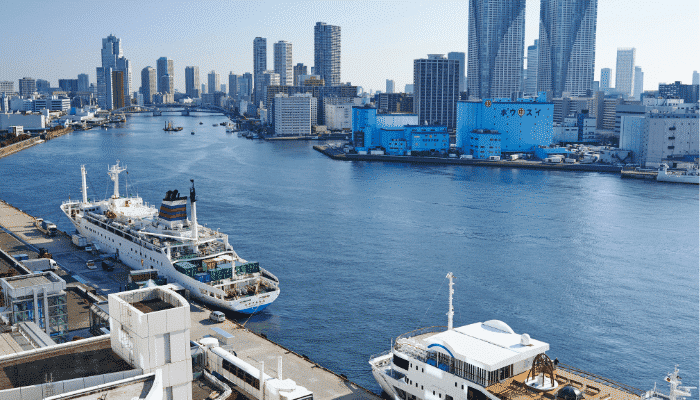
Today, the Port of Tokyo is still one of the biggest seaports in Japan and the Pacific, with an annual handling capacity of about 90 million tonnes. More than 40,000 people are employed at its various terminals and facilities. The Tokyo Port authority owns this port and in 2019 it handled 2.46 million TEU of container imports, a figure bigger than the other Japanese ports.
Tokyo Port spans 1000 hectares and it comprises 204 wharves, and 15 berths for handling containers, numerous storage yards and cold storage facilities. It distributes food products, steel goods, paper, vehicles etc within Japan to regions like Hokkaido. It also has international trade relations with China, South Korea, Southeast Asian countries, the Americas and also Europe.
It has many many terminals. The Oi terminal spans 235 acres, has 7 piers and can handle ships weighing about 51,000 DWT. It has 20 cranes and can deal with 58,000 TEUs annually. About 45 shipping companies conduct operations at this terminal and it has a storage space spanning 34 hectares.
Aomi Terminal comprises 5 berths and can handle ships weighing 36,000 DWT. It handles 25,000 TEUs and has 1,336 reefer points. The Shinagawa Terminal spans 24 acres and its 3 berths handle international shipments, have 5 cranes and can handle 6000 TEUs.
Bulk cargo such as wheat, fruits, vegetables, and marine produce is handled at the Oi Food Terminal and Oi Marine Terminal respectively. Imports of Lumber from the US, Malaysia etc are handled at the Lumber Terminal. Tsukishima Terminal deals with seafood whereas the Takeshiba terminal deals with agricultural produce.
Shinagawa Terminal handles vehicles and newsprints while Tatsumi deals with steel goods. Tokyo port has passenger terminals as well, the most famous being the Harumi cruise terminal.
Kobe Port
The fourth busiest port in the country, the Kobe port is located on the island of Honshu and has an annual cargo handling capacity of 80 million tonnes. It has 34 berths for handling containers. It is now a part of the bigger Hanshin port. It deals with around 8500 ships, 86,000,000 tonnes of general cargo, 2,500,000 TEU and 3000 passengers every year.
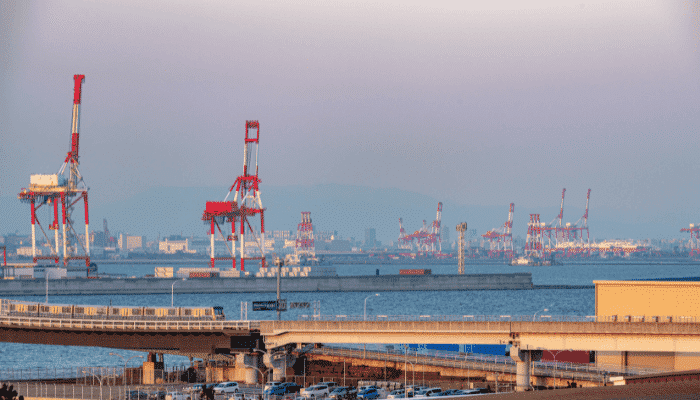
In 2019, it handled 2,864,145 TEU of containerised cargo, 1,178,488 TEU of export cargo and 1,006,807 TEU imports.
This port is owned by the city of Kobe’s government. It has a well-sheltered harbour that has had trade relations with Korea and China since ancient times. It has a favourable geographical location that connects it to more than 450 port cities worldwide. It is not only an important trading port but a famous tourist destination too. The port has two terminals for passenger cruises and ferries.
Kobe port possesses 6 container terminals that span over 786,880m2. It also has 12 terminals for dealing with general bulk cargo. It has many berths and some of the important ones include- The RC2 berth that is owned and managed by Mitsui-Soko Limited. The RC4 berth is operated by Kawasaki Kisen Kaisha Limited. The general cargo terminals are managed by KPTC and they have a storage space spanning 5440 square meters.
There are many other terminals and berths leased out by different companies. Kobe port has boosted the industrial sector and Japan’s economy as it has encouraged the development of many Japanese industries near the harbour. It is also a fishing port, ships with huge trawlers can be seen frequently and the seafood is exported overseas from the Kobe port.
Port of Nagoya
Situated in Ise Bay, Nagoya port is the largest Japanese trading port, handling more than 10% of the total Japanese international trade. Japanese Car manufacturing Company Toyota exports most of its cars to different parts of the world from this port. About 1.4 million cars are exported every year to around 160 countries across the world. It also exports more than 114 thousand bikes.
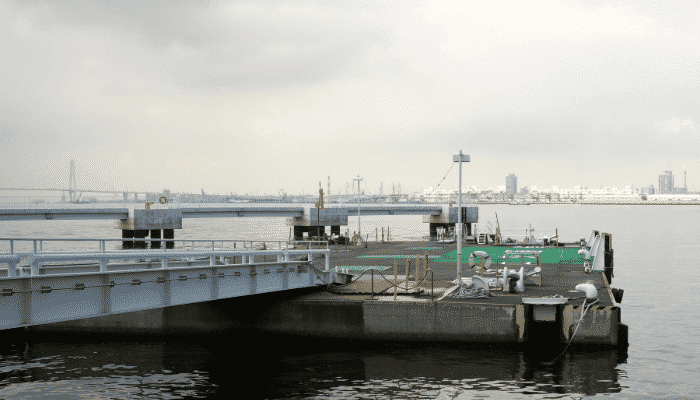
Apart from automobiles, it also deals with dry bulk and liquid cargo, containerised goods, liquefied gas, metal and metal products, packaged food, forest goods like logs etc. It has a naturally protected harbour and artificial breakwaters. It has trading relations with China, UAE, Saudi Arabia, Australia etc.
It is owned and managed by the Nagoya Port authority. It has 290 berths that span more than 33 kilometres. It has many warehouses spread over 278 hectares, 53 hectares of covered storage space, 74 hectares of coal storage warehouse etc.
It has 4 container terminals spanning 146 hectares and 12 berths. Two of these terminals are located on the Tobishima Pier- the South and the North Terminal. This Pier has five gantry cranes and other latest port equipment. It mainly trades with North America, Western Europe and Australia.
It also has bulk terminals such as the Shionogi wharf which has six docks for dealing with coal and steel goods. It can accommodate ships weighing 15,000 DWT. The port has 30 public berths for dealing with conventional cargo. Another pier called Kinjo handles automobiles on its five expansive berths. Inari Wharf deals with cotton and grains and Yokosuka wharf handles construction material. The Shiomi wharf deals with oil tankers and has 20 dedicated berths. The Garden wharf has a passenger terminal that handles cruises, boats and passenger ships.
Port of Osaka
Osaka port is situated in the Kinki region of Osaka, near Osaka Bay and is one of Japan’s leading ports. It can handle more than 80 million tonnes of cargo annually and has trade links with about 140 nations. In 2019, it handled a total of 85,507,578 tonnes of cargo, including 35,669,619 tonnes of container cargo and 49,835,000 ferry goods.
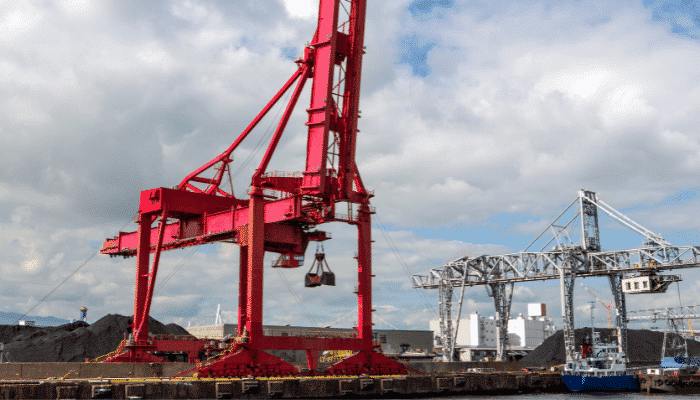
It spans 4.8 thousand hectares and comprises 181 berths including 70 berths for international shipments, 110 berths for inland trade and 13 berths for containerised cargo. It handles diverse cargo like iron, iron ores, vehicles, automobile parts, steel, wood pulp, agricultural produce, paper, construction material, particularly cement etc.
The Yumeshima container terminal spans 1350 meters. It has three berths handling trade from North America, Australia, Taiwan, South-East Asia etc. The Nanko district or Sakishima part of the port has 6 berths for handling international container shipments.
Maishima pier deals with fruits, veggies and has a multipurpose specialised berth for handling cars and RORO ships. It has 7 functional berths.
It also has a ferry terminal at Nanko that handled 900,000 tonnes and 60,000 people in 2018. The passenger terminal is known as the Tempozan cruise terminal and spans 370 m. It is visited by cruises and motorboats carrying tourists.
Port of Yokohama
The Yokohama port is owned by the Yokohama Ports Corporation. It handled about 35,000 vessels and about 350 million tonnes in 2019, including 2.9 million TEU of containerized cargo. It is one of the major ports in Japan and has ten wharves.
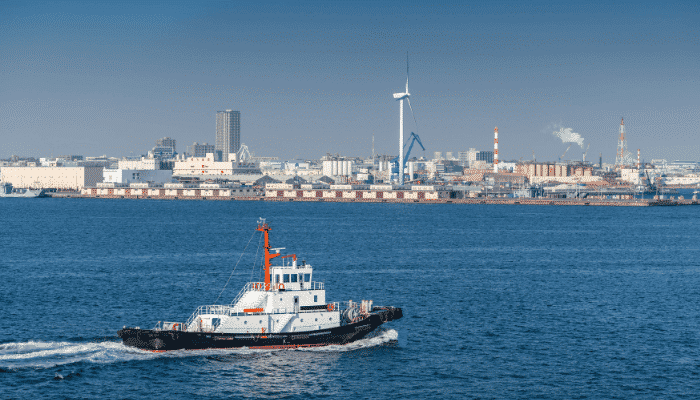
The Honmoku dock is the main port facility comprising 14 berths for handling containers and 10 general cargo berths. A newly developed facility is at the Minami Honmoku Pier that was opened in 2015. It has 4 berths spanning more than 400 meters that can accommodate huge container ships. This facility boasts 6 cranes and 22 container lines. More berths are being built to handle the increasing volume of traffic.
The Osanbashi wharf handles passenger ships and cruises, the Detamachi wharf handles fruits and vegetable imports, and the Daikoku dock offers logistics services, has 7 berths and huge warehouses.
The Kanazawa pier deals with timber, metal scrap, wood products, construction material such as sand, gravel, stone etc.
Conclusion
Japanese ports are one of the drivers of the nation’s economy. The revenue earned from international trade aids in building transport infrastructure and health services, which Japan is renowned for. Ports add significantly to the GDP and propel further industrial and technological advancements. Not only development, but these ports have led to the creation of many jobs and have imbibed the local communities into their functioning, providing additional income to numerous rural households.
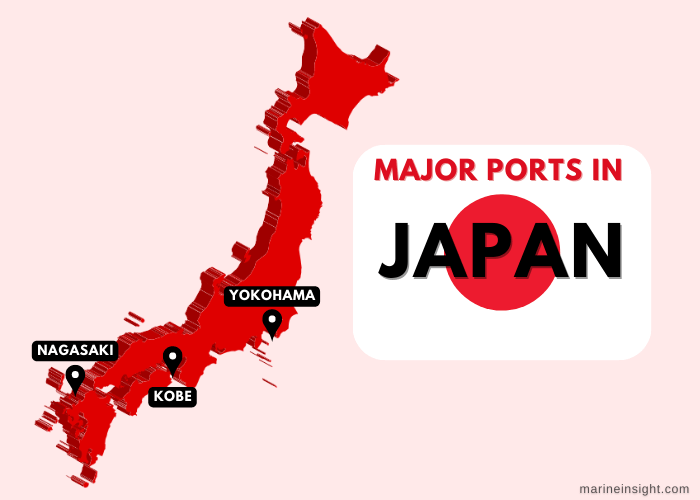
You might also like to read:
- 4 Major Ports in Panama
- 10 Major Ports in Romania
- 3 Major Ports of El Salvador
- 3 Major Ports of Angola
Disclaimer :
The information contained in this website is for general information purposes only. While we endeavour to keep the information up to date and correct, we make no representations or warranties of any kind, express or implied, about the completeness, accuracy, reliability, suitability or availability with respect to the website or the information, products, services, or related graphics contained on the website for any purpose. Any reliance you place on such information is therefore strictly at your own risk.
In no event will we be liable for any loss or damage including without limitation, indirect or consequential loss or damage, or any loss or damage whatsoever arising from loss of data or profits arising out of, or in connection with, the use of this website.
Do you have info to share with us ? Suggest a correction
Disclaimer :
The information contained in this website is for general information purposes only. While we endeavour to keep the information up to date and correct, we make no representations or warranties of any kind, express or implied, about the completeness, accuracy, reliability, suitability or availability with respect to the website or the information, products, services, or related graphics contained on the website for any purpose. Any reliance you place on such information is therefore strictly at your own risk.
In no event will we be liable for any loss or damage including without limitation, indirect or consequential loss or damage, or any loss or damage whatsoever arising from loss of data or profits arising out of, or in connection with, the use of this website.
Latest Maritime Knowledge Articles You Would Like:
Subscribe To Our Newsletters
By subscribing, you agree to our Privacy Policy and may receive occasional deal communications; you can unsubscribe anytime.















